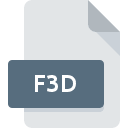.F3D File Extension

Fusion 360 Archive File
| Developer | Autodesk |
| Popularity | |
| Category | 3D Image Files |
| Format | .F3D |
| Cross Platform | Update Soon |
What is an F3D file?
The .F3D file extension is associated with Autodesk’s Fusion 360, a cloud-based 3D CAD, CAM, and CAE tool that is widely used in various industries for product design and manufacturing.
The .F3D file is essentially an archive file that stores a complete 3D design project, including all the components, materials, animations, and other necessary data.
These files are central to the workflow in Fusion 360, enabling users to save, share, and revisit complex design projects with all associated elements intact.
More Information.
Fusion 360 was conceived during a time when the demand for cloud-based solutions and collaborative tools was on the rise.
Traditional CAD tools were often siloed, with different teams working in isolation using separate tools for design, engineering, and manufacturing.
Fusion 360 aimed to bridge these gaps by providing a unified platform that supported the entire product development process, from concept to production. The .F3D file format played a crucial role in this vision by enabling seamless storage and sharing of all project data.
Initially, the .F3D file was intended to serve as a comprehensive container for all aspects of a 3D design, including sketches, models, assemblies, and simulations.
This format allowed engineers and designers to work collaboratively, sharing files without losing any project details.
Over time, as Fusion 360 evolved, so did the capabilities of the .F3D file, supporting more complex data and integrations with other Autodesk tools and third-party software.
Origin Of This File.
The .F3D file format was developed by Autodesk, a leader in the software industry known for its design software like AutoCAD, Maya, and 3ds Max.
As the industry shifted towards more integrated and collaborative workflows, Autodesk introduced Fusion 360 in 2013, a revolutionary platform that combined CAD, CAM, and CAE functionalities into one.
The .F3D file format was created specifically for Fusion 360 to meet the needs of this all-in-one design tool, allowing users to encapsulate a complete project in a single, portable file.
File Structure Technical Specification.
The .F3D file is essentially a compressed archive that contains various types of data. The file structure is organized in such a way that it can hold all the necessary components of a Fusion 360 project, ensuring that everything from the basic sketches to the final assembly is stored within a single file.
Here’s a breakdown of what an .F3D file typically includes:
- Design Data: This includes the 3D models, sketches, and assemblies that make up the core of the design project.
- Materials and Textures: Information about the materials used in the design, including textures and appearances, is stored to ensure that the visual aspects of the project are preserved.
- Simulation Data: If the project includes simulations, such as stress tests or motion studies, this data is also stored within the .F3D file.
- Manufacturing Data: Toolpaths and other CAM-related data are stored to ensure that the design can be directly used for manufacturing.
- Metadata: Information such as the project’s name, version history, and author details are stored as metadata within the file.
The .F3D file is a binary format that is optimized for performance, ensuring that even complex projects with large amounts of data can be stored and accessed efficiently.
How to Convert the File?
Converting .F3D files to other formats is possible, particularly if you need to use the data in different software. Fusion 360 provides several export options:
- Export as STL: For 3D printing, you can export the .F3D file as an STL file, which is widely supported by most 3D printers and slicing software.
- Export as STEP or IGES: These are common formats for sharing CAD data between different software. Fusion 360 allows you to export .F3D files as STEP (.stp, .step) or IGES (.igs, .iges) files, which can be imported into other CAD programs.
- Export as DXF: If you need to share 2D drawings, you can export parts of your .F3D file as a DXF file, which is compatible with many 2D CAD systems.
- Export as OBJ: For use in animation or game development software, you can export .F3D files as OBJ files, which are commonly used in 3D modeling applications.
Advantages And Disadvantages.
Advantages:
- Comprehensive Storage: The .F3D file can store all elements of a Fusion 360 project in one file, making it easy to manage and share projects.
- Portability: As an archive file, .F3D can be easily shared across different platforms and users without the need to transfer multiple files separately.
- Version Control: Fusion 360’s integration with the cloud allows for easy version control and collaboration, with the .F3D file serving as a central repository for all project data.
- Integration: The .F3D format supports integration with other Autodesk products, allowing for a seamless workflow across different stages of product development.
Disadvantages:
- Proprietary Format: The .F3D file is proprietary to Autodesk, meaning it can only be fully utilized within Fusion 360. This can be a limitation for users who want to work with other CAD software.
- File Size: Due to the comprehensive nature of the .F3D file, it can become quite large, especially for complex projects. This can make file transfer and storage more challenging.
- Dependence on Fusion 360: Since the .F3D file is closely tied to Fusion 360, users are dependent on having access to this software to open and edit the files, which could be a limitation in environments where Fusion 360 is not available.
How to Open F3D?
Open In Windows
- Install Autodesk Fusion 360 from the official website.
- Open the software and use the
File>Openmenu to load your .F3D file.
Open In Linux
- Fusion 360 is not natively supported on Linux, but you can use a virtual machine or compatibility layer like Wine to run the software. Alternatively, you can convert the .F3D file to another format that is compatible with Linux-supported CAD software.
Open In MAC
- Similar to Windows, Fusion 360 is available for macOS. Install the software, and open your .F3D file through the application.












